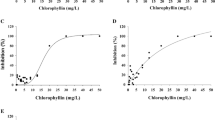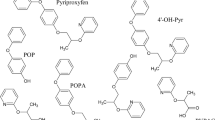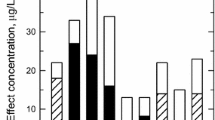Abstract
Species differences were seen among fresh-water invertebrates and fishes in the absorption and subsequent retention of photodieldrin (a sunlight conversion product of the insecticide, dieldrin). The crayfishCambarus and the clamSimpsoniconcha showed extremely low levels of absorption and accumulation while the larvae of the mosquitoAedes, the amphipodGammarus, and the cladoceransSimocephalus, and fresh-water fleaDaphnia showed much higher levels of this insecticide. Maximum absorption occurred within 12 to 24 hours of exposure in only a few invertebrates but in most fishes. Among fishes, five to six times higher levels were seen during this period in guppy and goldfish than in minnow and bluegill. While the livebearer, guppy, kept absorbing photodieldrin with time, other fishes showed a slight decline in their tissue levels of this insecticide. The maximum biological magnification ratios during peak periods of absorption were: 133 for bluegill, 150 for minnow, 609 for goldfish, and 820 for guppy. Among microcrustacea the maximum biological magnification ratios seen after four days of continuous exposure were about 1000 forSimocephalus, 1200 forGammarus, and 63,000 forDaphnia. No appreciablein vivo metabolism of photodieldrin was seen in fishes, minnow and bluegill, and the decline in their body levels of photodieldrin is apparently not due to detoxication of the latter.
Similar content being viewed by others
References
Benson, W.: Note on nomenclature of dieldrin and related compounds. J. Assoc. Offic. Anal. Chem.52, 1109 (1969).
Brodie, B. B., and R. P. Maickel: Comparative biochemistry of drug metabolism. Proceed. 1st Internat. Pharmacol. Meeting Vol. 6, p. 299, Pergamon Press (1961).
Gackstatter, J. H., and C. M. Weiss: The elimination of DDT-C14, dieldrin-C14, and lindane-C14 from fish following a single sublethal exposure in aquaria. Trans. Am. Fish. Soc.96, 301 (1967).
Johnson, B. T., C. R. Saunders, H. O. Saunders, and R. S. Campbell: Biological magnification and degradation of DDT and aldrin by fresh-water invertebrates. J. Fish. Res. Bd. Canada28, 705 (1971).
Jorgenson, C. B., and E. D. Goldberg: Partial filtration in relation to feeding in moluscs, especially in Mytilus. Biol. Bull.105, 477 (1953).
Kenaga, E. E.: Factors related to bioconcentration of pesticides: In Environmental Toxicology of Pesticides: (F. Matsummura, M. G. Bousch and T. Misato, editors), p. 193, Academic Press, (1972).
Khan, M. A. Q., and F. Matsumura: Induction of mixed-function oxidase and protein synthesis by DDT and dieldrin in German and American cockroaches. Pest. Biochem. Physiol.2, 236 (1972).
Khan, M. A. Q., R. H. Stanton, D. J. Sutherland, J. D. Rosen, and N. Maitra: Toxicity and metabolism relationship of the photoisomers of cyclodienes. Archiv. Environ. Contam. Toxicol.1, 159 (1973).
Khan, M. A. Q., J. D. Rosen, and D. J. Sutherland: Insect metabolism of photoaldrin and photodieldrin. Science164, 318 (1969).
Khan, M. A. Q., D. J. Sutherland, J. D. Rosen, and W. F. Carey: Effects of Sesamex on the toxicity and metabolism of cyclodienes and their photoisomers in houseflies. J. Econ. Entomol.63, 470 (1970).
Klein, A. K., J. D. Link, and N. J. Ives: Metabolites isolated from urine of rats fed14C-photodieldrin. J. Assoc. Offic. Anal. Chem.51, 895 (1968).
Krogh, A.: A comparative physiology of respiratory mechanisms. Univ. of Penna. Press. (1945) 172 pp.
Mount, D. I., and G. J. Putnicki: Trans. N. Am. Wildlife Natur. Resources Conf.31, 177 (1966).
O'Brien, R. D.: Insecticides: Action and metabolism, Acad. Press, (1967) 328 pp.
Prosser, C. L., and F. A. Brown, Jr.: Comparative Animal Physiology. W. B. Saunders, (1961) 688 pp.
Rio, D. F., and M. A. Q. Khan: Absorption and elimination of dieldrin by fresh-water algae andDaphnia. (In preparation).
Rosen, J. D., and W. F. Carey: Preparation of the photoisomers of aldrin and dieldrin. J. Agr. Food Chem.16, 536 (1968).
Rosen, J. D., D. J. Sutherland, and G. R. Lipton: Photochemical isomerization of dieldrin and endrin and effects on toxicity. Bull. Environ. Contamn. Toxicol.1, 133 (1966).
Wilson, A. J.: Chemical Assays: Ann. Rep. Bur. Commer. Fisher. Biol. Lab., Gulf Breeze. Fla., the fiscal year ending June, 1965, U. S. Bur. Commer. Fish. Circ.247, pp 6–7 (1965).
Woodwell, G. M., C. F. Wurster, and P. A. Isaacson: DDT residues in an East Coast estuary, a case of biological concentration of a persistent insecticide. Science156, 821 (1967).
Author information
Authors and Affiliations
Rights and permissions
About this article
Cite this article
Khan, H.M., Khan, M.A.Q. Biological magnification of photodieldrin by food chain organisms. Arch. Environ. Contam. Toxicol. 2, 289–301 (1974). https://doi.org/10.1007/BF02047095
Received:
Accepted:
Issue Date:
DOI: https://doi.org/10.1007/BF02047095




